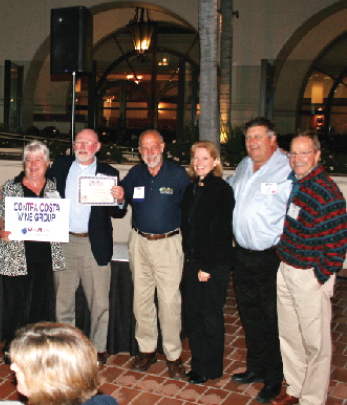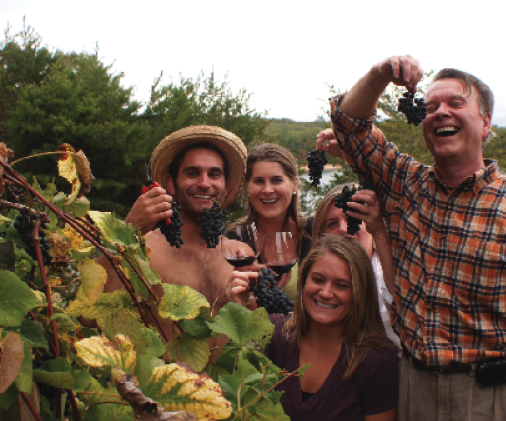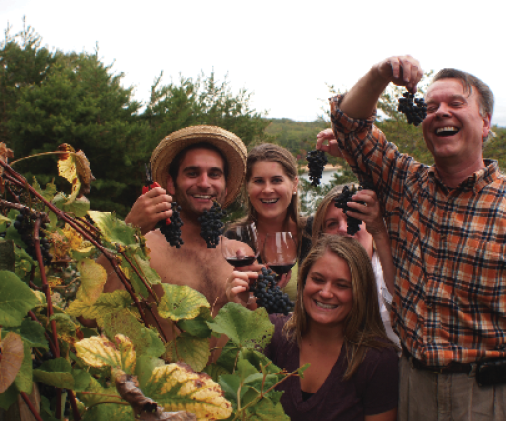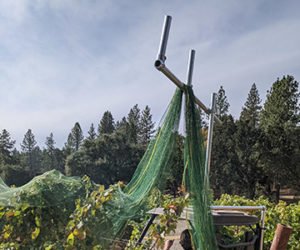 It is a refrain that I never tire of. “Connect with local growers!”
It is a refrain that I never tire of. “Connect with local growers!”
You’ve read that insistent verse in almost every article I’ve penned for this magazine over the last dozen years or so, and at this year’s WineMaker Magazine Conference in Monterey, California, I had a lot of great discussions with backyard vine warriors about how to engage with existing winegrowing communities, or how to start a community when there are none to join.
So the focus for this article is community; specifically the communities of home winegrowers that like to get together, in person or virtually, to discuss winegrape production, taste one another’s homegrown wines, share their passion and knowledge, and work diligently to improve the wines grown and made in a specific locale.
Let’s break the discussion into two sections: how to join an existing community, and how to start a grape growing community where none currently exist (or where the group isn’t to your liking). To focus your attention and desires, I have also provided some questions on the following pages to get you thinking about what you hope to learn, what you can contribute, the type of experience you want to engage in, and how wide you want to cast your net geographically.
Some suggestions to make best use of your valuable time:
1. Viticulture must be understood physically. You cannot learn to prune or manage a canopy only from a conversation, viewing a YouTube video or taking a class. Being in the vineyard, touching the vine, making pruning cuts, learning how much pressure you can put on a shoot before it breaks, digging down a few feet in your soil to see the changes and water status — these are the real-world exercises that will inform your body and mind in the hobby of winegrape growing. If you can’t commit to the intense physical labor necessary for establishing, farming and harvesting winegrapes, you should consider finding a landscaping company that has experience in vineyards, or just buy grapes from an established producer.
2. Join or create a group that focuses on a specific area and the challenges in winegrowing that are defined by your region. It’s nice to have a few dozen members in a club, but having three members that are very committed and communicative may lead to better grapes than a large, slightly uninterested group.
3. Learn to taste like a pro (or an advanced amateur) before joining a community that tastes home wines. It’s even easier to find a wine tasting group than a growing community, so find a group of fun, like-minded folks that taste every week or month, usually with a theme, and definitely blind, and get your palate ready to recognize balance, fruit, structure, aroma, bouquet and the major flaws and flavor profiles of popular local varieties.
4. Always make sure the meetings include wine and food. A meeting will always be well attended if it has a reputation for providing wine and something to nibble on. Talking about winegrowing without tasting wines from people’s vineyards is like discussing literature without choosing a specific book. Encourage technical tastings, and become comfortable with giving and receiving criticism.
5. Join or create a club that switches hosts so you all get to visit each other’s vineyards during the spring and summer. You may also want to create or join a community that works together in members’ vineyards and gathers for harvest, pruning or times of need.
My definition of a great home winegrowing community:
 1. Members that are equally committed to growing better wine each vintage.
1. Members that are equally committed to growing better wine each vintage.
2. A good mix of online chat, real-world vineyard workdays, field trips, guest speakers, wine tasting (dormancy?), and a group that are good enough friends to forget wine sometimes and go fishing, hunting, or take a trip to a local tasting room. Eat, drink and play together too!
3. Folks that have the same wine goals as you do, e.g. making ripe wines, making elegant wines, growing Zinfandel, or growing Marquette. Diversity of opinion is also important as it helps challenge the status quo of your winegrowing, but it’s good to have basic consensus on subjects like what constitutes a quality wine.
4. Try to choose a group of growers that you get along with, but are not complacent with. In other words, you want a group that you enjoy, but do not like every wine they taste. Their technical knowledge of wine and a desire for regional quality should drive the conversation. If no one is pushing you to farm and craft better wine, why are you attending?
5. Members live within an hour — two at the most — from each other so gathering and working together is tenable.
6. Have an email group (Listserve) or web-based bulletin board for folks to chat, post and discuss tasting, growing and winemaking on a daily basis. Alternatively, your group can engage in an existing community, such as www.reddit.com/r/viticulture, which I created for the WineMaker community. It’s empty now, but we can fill it up! Communicating can be as easy as sending emails back and forth or as intense as Skype sessions from the vineyard!
Joining an existing grape growing community
Answer these questions to get a better understanding of what you want from an existing winegrowing/winemaking club:
• The specific knowledge I want to gain from a Club/Community of winegrowers is:
• The specific areas of expertise I can pass along within a community of growers is:
• I want to work with growers that are interested in the following grapes and growing in the following areas:
• Do you want to be in a group that meets in person? Tastes wine? Is totally web-based? Takes field trips?
How to find an existing home winegrowing group:
Step One: Start with the telephone and call any local growers you know to see if they know of a club, shop or community to join. Determine if there is an existing winegrowing group near you. Choose the largest city near you and do a Google search like, “Los Angeles home winemaking.” You can also search for stores that provide home winemaking equipment. Many winemaking supply stores are associated with a club and host meetings in their building. Pick up some yeast and a graduated cylinder while you’re there!
Step Two: Broaden your search to academics and broad geographical areas. There will be hinterlands of the winegrowing firmament that will make finding a club impossible. If you live in northern New Mexico or Southern North Dakota, you may have to get your home winemaking knowledge from folks in California or Minnesota. Still searching? Find email addresses for a local university or college that has a winemaking or horticulture program and send the professors an email asking what they would recommend for someone who wants to grow quality wine in their state or region of the country.
Step Three: If there is no option to join an existing community, determine whether there is ample local interest to start a winegrowing club. Remember: a club can have just two members!
Being of value to your home winegrowing club
Being valuable to your new or existing winegrowing community is 90% willingness, 10% knowledge. When I first moved to the western Santa Ynez Valley to grow grapes, I went to as many tastings and industry events as possible, tasted every wine I could, took notes, and showed up early to set up and stayed late to help break down. Engaging in a meaningful way is as easy as putting work in. This process led me to my first job in 1996 as a cellar rat at Babcock Winery, and also put me in a position to volunteer to research and write the petition to establish the Santa Rita Hills American Viticultural Area. Be-fore I knew it, still a young man, I was recognized as an expert in the area. And even though you may be looking to join or start a club, and not start a new winegrowing region, the message is the same: network, visit the veteran winegrowers and winemakers, volunteer at events — basically make your-self useful.
Become an expert. If you grow grapes in Montana, learn Marquette and St. Pepin. If you’re in Napa Valley, learn Cabernet Sauvignon and Sauvignon Blanc. The more wines you taste, the more vineyards you visit and work in, the more you can offer your club and you will observe more meaningful improvements to your growing and winemaking. If there’s not another ‘leader’ to start the club or lead the club, become the leader you desire!
Support the professionals. A good relationship with commercial vineyards and wineries goes a long way for a com-munity of home winegrowers. Need to learn to prune or pluck leaves? Want to see some cool equipment or how a commercial vineyard/winery does racking or barrel washing? Join some wine clubs, buy as much local wine as you can afford, and chat up winemakers or their crew during tastings and events.
Communicate often and clearly with your club. Your community has to be reminded to be communicative. An active bulletin board or email exchange is a good start. Chatting both socially and viticulturally will keep folks chummy and connected. Drinking with the group will make this happen as well.
Choose winemakers for your group that are as interested in the craft of growing and making wine as they are in the intoxicating effects of ethanol. In other words, don’t invite people who get drunk and stupid. People will avoid meetings or houses of those that can’t drink like a lady or a gentleman. You can enjoy the feeling of drinking wine without allowing the spirit to get the best of you. And remember, many folks will have to drive.
Reach out to existing, successful winegrowing clubs and ask how they started and established their group. A great place to do this each year is at the WineMaker Magazine Conference!
Starting your own winegrowers’ club:
Answer these questions to help understand what type of winegrape growing community you are interested in starting:
• What counties, cities or viticultural areas do you consider to be part of your community? (Try to choose an area that is wide enough to encourage a large membership, but defined enough to allow specific practices and conversations to be valuable for all members.)
• What 3-5 grape varieties would you use as a focus for the club? These will not limit membership, but serve to focus your study and education for producing successful wines in the region you live.
• How often do you want to meet with the group? How often would you meet on bulletin boards? Through email? How many field trips? Does each member’s vineyard get one day of combined club-labor? What local commercial vineyards or wineries may help host, sponsor, or teach the club?
• How big do you imagine the club becoming? Do you imagine a tight-knit group of a few friends or a wider organization that really reaches out to all winegrowers in the area?
• Will there be membership dues or a minimum number of meetings to attend each year? Will the club travel as a group to the WineMaker Magazine Conference to show their wines and network with fellow winegrowers and winemakers?
Conclusion:
Since the hazy prehistory of humans, community has changed little. For almost 10,000 years human beings have worked together to produce alcoholic beverages, in fact the first fermented beverages (beer, mead, wine) enabled mankind to keep food calories from season to season, giving humans the chance to specialize in specific jobs: growing grain, making pottery, inventing a writing system to keep count of stores in the granary, jars of beer, etc. Gathering around a wine-jar or a barrel of beer is one of the most natural behaviors a human being can engage in. Having a conversation about the wines you taste is another natural expression of ancient humanity.
So alcohol is integral to human community, perhaps even the mother of it. So we are just following a natural process of humans wanting to gather to discuss and drink. In this way, forming or supporting a winegrowing community is very natural for human beings, and should occur almost organically. It won’t take much effort to get together with other people who love what you love, have a few sips and discuss how to grow and make better wine.
If the words “club” or “community” did not exist, I believe wine drinkers would invent them independently. In other words, make the club fun and informative and it will build itself.





